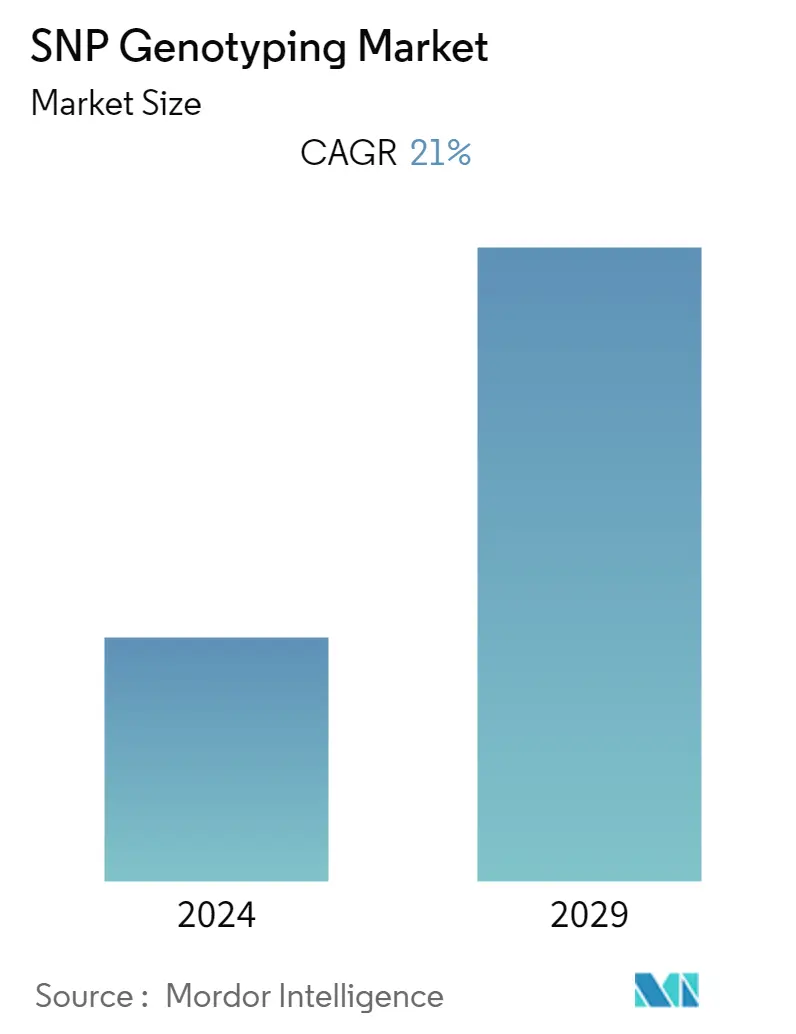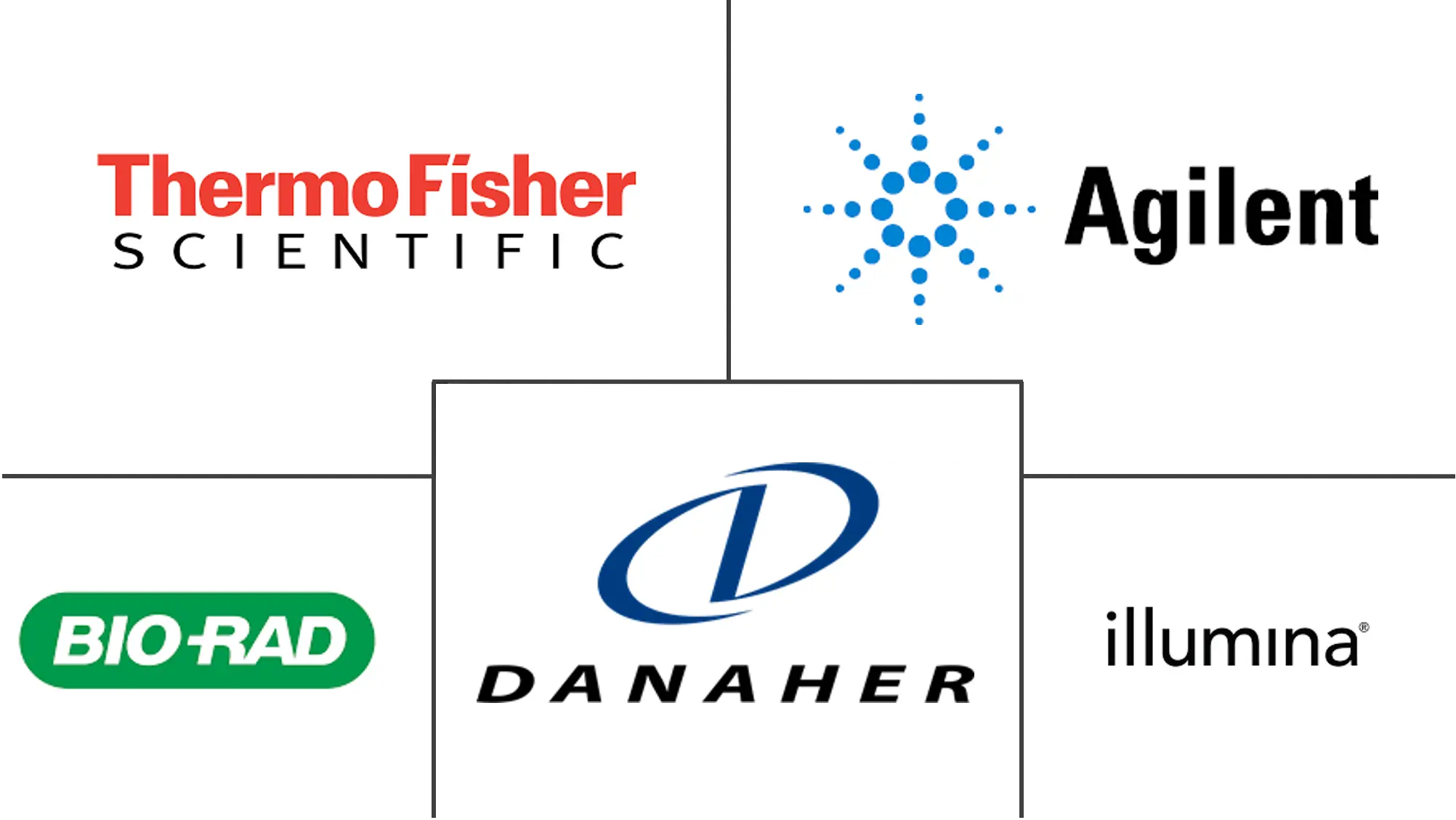Market Size of SNP Genotyping Industry

| Study Period | 2021 - 2029 |
| Base Year For Estimation | 2023 |
| CAGR | 21.00 % |
| Fastest Growing Market | Asia Pacific |
| Largest Market | North America |
| Market Concentration | Low |
Major Players
*Disclaimer: Major Players sorted in no particular order |
Need a report that reflects how COVID-19 has impacted this market and its growth?
SNP Genotyping Market Analysis
The SNP Genotyping Market is expected to register a CAGR of 21% over the forecast period.
The COVID-19 pandemic significantly impacted the SNP Genotyping market. Detecting SARS-CoV-2 variants with SNP genotyping is boosting market growth. For instance, a research study by Helen Harper et al., published in PLOS ONE Journal in February 2021, found that PACE (PCR Allele Competitive Extension) SNP genotyping assays provide useful viral genotype identification for SARS-CoV-2 positive samples. The advantage of PACE-RT SNP genotyping technology is that the SNP panel can be modified at a low cost on a regular basis. With the emergence of several COVID-19 variants, PACE-RT SNP genotyping approach could provide a useful tool for epidemiological surveillance. Owing to the increasing genotype research and development activities and bioinformatics in the development of diagnostic tools or effective therapeutics for COVID-19, the market is likely to continue its significant growth rate during the forecast period.
The major factors fueling the market growth are the miniaturization of equipment and instruments and increased multiplexing capacity leading to increased application. SNP technologies are extensively utilized for detection and are beneficial in the etiology of several human diseases, such as cancer, cardiovascular, Alzheimer's, and asthma, among others. For instance, according to a study published by Elsevier in August 2021, SNP-based methods were compared and evaluated regarding their potential for integration in a miniaturized device. Regarding SNP-based methods, two approaches were explored in this study: real-time allele-specific PCR and HRM analysis. Allele-specific PCR was the best option for miniaturization since the results condensed to a presence/absence type of answer for the target allele, and it showed the best results for both pure and mixed varieties. Therefore, rising applications of SNPs in several life sciences and biotechnology aspects are driving the SNP genotyping market.
Furthermore, the launch of new biological products, acquisitions, collaborations, and regional expansions are some of the strategic initiatives being taken by the companies to maintain stability in the market. For instance, in October 2021, NRGene launched Soy SNPro. This is the first product in a line of optimized pre-designed SNP sets for genotyping (DNA tests) of various crops that will significantly improve breeding program efficiency. This is likely to fuel market growth in the near future.
Therefore, the factors mentioned above are collectively responsible for the growth of the studied market over the forecast period. However, the lack of standardization in SNP processes and privacy concerns posing a threat to broad technology applications are the major factors hindering market growth.
SNP Genotyping Industry Segmentation
As per the scope of the report, single-nucleotide polymorphism (SNP) refers to mutations found at a specific locus or single base-pair mutation containing two alleles. SNPs aid in understanding the correlations between the genotype and behavior indicated by all living organisms. The SNP Genotyping Market is Segmented by Technology (TaqMan SNP Genotyping, Massarray SNP Genotyping, SNP GeneChip Arrays, and Other Techniques), End User (Pharmacogenomics and Diagnostic Field), and Geography (North America, Europe, Asia-Pacific, Middle-East and Africa, and South America). The market report also covers the estimated market sizes and trends for 17 different countries across major regions globally. The report offers the value (in USD million) for the above segments.
| Technology | |
| TaqMan SNP Genotyping | |
| Massarray SNP Genotyping | |
| SNP GeneChip Arrays | |
| Other Technologies |
| End User | |
| Pharmacogenomics | |
| Diagnostic Field |
| Geography | ||||||||
| ||||||||
| ||||||||
| ||||||||
| ||||||||
|
SNP Genotyping Market Size Summary
The SNP genotyping market is poised for substantial growth, driven by advancements in technology and increasing applications across various fields. The market is experiencing a surge in demand due to the miniaturization of equipment and enhanced multiplexing capabilities, which have expanded the use of SNP technologies in detecting and understanding human diseases such as cancer, cardiovascular conditions, Alzheimer's, and asthma. The COVID-19 pandemic has further accelerated market growth, as SNP genotyping plays a crucial role in identifying SARS-CoV-2 variants, thereby aiding epidemiological surveillance. The development of cost-effective and adaptable SNP panels, like the PACE-RT technology, underscores the market's potential in diagnostic and therapeutic applications. Strategic initiatives such as product launches, collaborations, and regional expansions by key players are also contributing to the market's dynamic landscape.
Pharmacogenomics is a significant segment within the SNP genotyping market, driven by the growing pipeline for personalized medicine and novel drug delivery systems. The integration of SNP-based methods in drug development is enhancing the precision of medical decision-making, as evidenced by initiatives like the Estonian biobank project. In North America, particularly the United States, the market is expected to witness robust growth due to the high prevalence of chronic diseases and substantial investments in healthcare innovations. The competitive landscape is characterized by the presence of both global and regional companies, with major players like Agilent Technologies, Bio-Rad Laboratories, and Illumina Inc. holding significant market shares. Despite challenges such as lack of standardization and privacy concerns, the SNP genotyping market is set to expand, supported by ongoing research, technological advancements, and strategic industry collaborations.
SNP Genotyping Market Size - Table of Contents
-
1. MARKET DYNAMICS
-
1.1 Market Overview
-
1.2 Market Drivers
-
1.2.1 Miniaturisation of Equipment and Instruments
-
1.2.2 Increased Multiplexing Capacity Leading to Increased Application
-
-
1.3 Market Restraints
-
1.3.1 Lack of Standardisation in SNP Processes
-
1.3.2 Privacy Concerns Pose a Threat to Broad Technology Adoption
-
-
1.4 Porter's Five Forces Analysis
-
1.4.1 Threat of New Entrants
-
1.4.2 Bargaining Power of Buyers/Consumers
-
1.4.3 Bargaining Power of Suppliers
-
1.4.4 Threat of Substitute Products and Services
-
1.4.5 Intensity of Competitive Rivalry
-
-
-
2. MARKET SEGMENTATION (Market Size by Value - USD Million)
-
2.1 Technology
-
2.1.1 TaqMan SNP Genotyping
-
2.1.2 Massarray SNP Genotyping
-
2.1.3 SNP GeneChip Arrays
-
2.1.4 Other Technologies
-
-
2.2 End User
-
2.2.1 Pharmacogenomics
-
2.2.2 Diagnostic Field
-
-
2.3 Geography
-
2.3.1 North America
-
2.3.1.1 United States
-
2.3.1.2 Canada
-
2.3.1.3 Mexico
-
-
2.3.2 Europe
-
2.3.2.1 Germany
-
2.3.2.2 United Kingdom
-
2.3.2.3 France
-
2.3.2.4 Italy
-
2.3.2.5 Spain
-
2.3.2.6 Rest of Europe
-
-
2.3.3 Asia-Pacific
-
2.3.3.1 China
-
2.3.3.2 Japan
-
2.3.3.3 India
-
2.3.3.4 Australia
-
2.3.3.5 South Korea
-
2.3.3.6 Rest of Asia-Pacific
-
-
2.3.4 Middle-East and Africa
-
2.3.4.1 GCC
-
2.3.4.2 South Africa
-
2.3.4.3 Rest of Middle-East and Africa
-
-
2.3.5 South America
-
2.3.5.1 Brazil
-
2.3.5.2 Argentina
-
2.3.5.3 Rest of South America
-
-
-
SNP Genotyping Market Size FAQs
What is the current SNP Genotyping Market size?
The SNP Genotyping Market is projected to register a CAGR of 21% during the forecast period (2024-2029)
Who are the key players in SNP Genotyping Market?
Thermo Fisher Scientific Inc., Agilent Technologies, Bio-Rad Laboratories Inc., Illumina Inc. and Danaher Corporation are the major companies operating in the SNP Genotyping Market.

